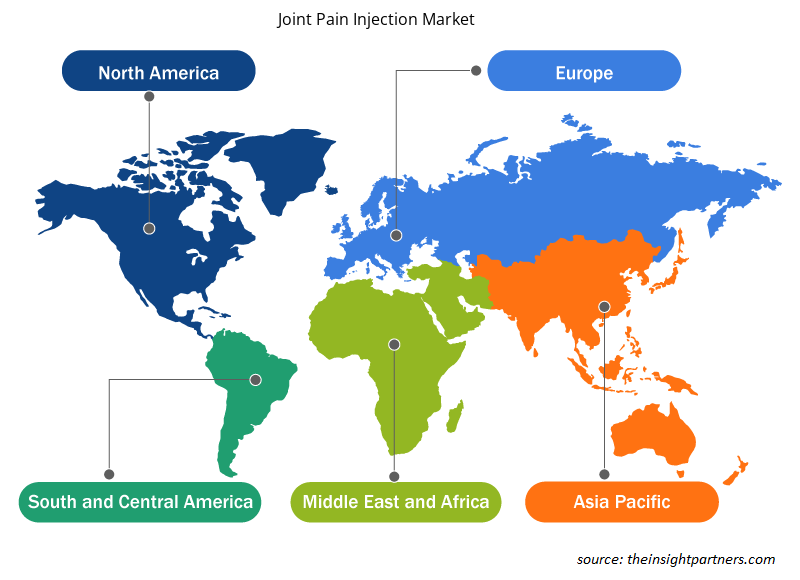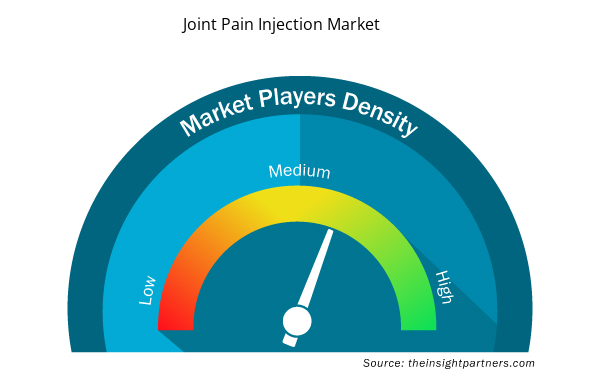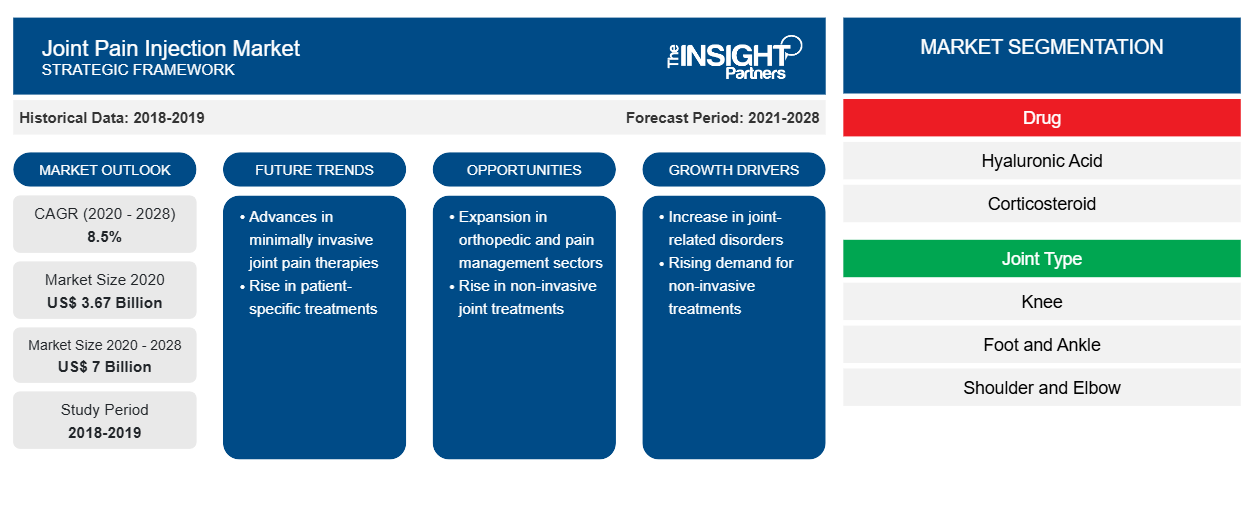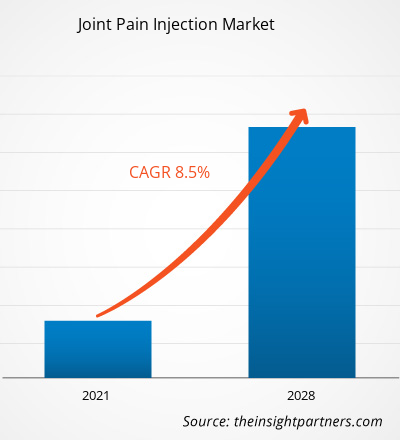[Informe de investigación] Se espera que el mercado de inyecciones para el dolor en las articulaciones alcance los US$ 6.996,88 millones para 2028 desde los US$ 3.667,45 millones en 2020; se estima que crecerá a una CAGR del 8,5% durante 2021-2028.
Las inyecciones para el dolor articular proporcionan un alivio más rápido del dolor intenso y reducen la inflamación de las articulaciones. Entre los distintos tipos de inyecciones disponibles en el mercado se encuentran las inyecciones de corticosteroides, las inyecciones de ácido hialurónico (AH), las inyecciones de plasma rico en plaquetas (PRP) y las inyecciones de matriz de tejido placentario (PTM). El crecimiento del mercado de inyecciones para el dolor articular se atribuye a factores como la alta prevalencia de trastornos musculoesqueléticos y el aumento del número de lesiones deportivas. Sin embargo, los altos costos de las terapias de reparación de articulaciones obstaculizan el crecimiento del mercado.
Perspectivas del mercado
Alta prevalencia de trastornos musculoesqueléticos
Personalice este informe según sus necesidades
Obtendrá personalización en cualquier informe, sin cargo, incluidas partes de este informe o análisis a nivel de país, paquete de datos de Excel, así como también grandes ofertas y descuentos para empresas emergentes y universidades.
- Obtenga las principales tendencias clave del mercado de este informe.Esta muestra GRATUITA incluirá análisis de datos, desde tendencias del mercado hasta estimaciones y pronósticos.
Los trastornos musculoesqueléticos son afecciones médicas que afectan los músculos, los huesos y las articulaciones del cuello, los hombros, las muñecas, la espalda, las caderas, las piernas, las rodillas y los pies. Estas enfermedades incluyen tendinitis, síndrome del túnel carpiano, osteoartritis, artritis reumatoide (AR), fibromialgia y fracturas óseas. Según la hoja informativa de la Organización Mundial de la Salud (OMS) actualizada en 2018, las afecciones musculoesqueléticas son la segunda causa más importante de discapacidad en todo el mundo. Según la misma, se espera que la prevalencia y el impacto de los trastornos musculoesqueléticos aumenten con el aumento del envejecimiento de la población y el aumento de la prevalencia de los factores de riesgo de las enfermedades no transmisibles (ENT) en todo el mundo. Según los datos de la reunión anual de la Academia Estadounidense de Cirujanos Ortopédicos de 2016, aproximadamente 1 de cada 2 adultos sufre un trastorno musculoesquelético en los EE. UU. Además, según los Centros para el Control y la Prevención de Enfermedades (CDC), la artritis causa un dolor intenso que afecta a millones de personas en los EE. UU. cada año. Aproximadamente uno de cada cuatro pacientes con artritis, es decir, unos 15 millones de un total de unos 54 millones de pacientes, experimenta dolor articular intenso relacionado con la artritis.
Además, la osteoartritis (OA) es uno de los trastornos articulares más comunes en los EE. UU., causado por el deterioro del cartílago articular entre los huesos. También se conoce como enfermedad articular degenerativa o artritis por "desgaste". Según los Centros para el Control y la Prevención de Enfermedades (CDC), más de 32,5 millones de adultos en los EE. UU. sufren osteoartritis. De manera similar, según el Servicio Nacional de Salud (NHS), más de 10 millones de personas en el Reino Unido tienen artritis u otras afecciones similares que afectan las articulaciones. Según Bupa Health Insurance, la osteoartritis es la forma más común de artritis que prevalece en el Reino Unido, afecta a alrededor de un tercio de las personas de 45 años o más en el país, es decir, ~8,75 millones de personas. Por lo tanto, una prevalencia tan alta de trastornos musculoesqueléticos en diferentes países está aumentando el número de procedimientos de tratamiento que se llevan a cabo para los mismos, lo que impulsa el crecimiento del mercado de inyecciones para el dolor articular.
Perspectivas basadas en fármacos
El mercado de inyecciones para el dolor articular, por fármaco, está segmentado en ácido hialurónico, corticosteroides y otros. El segmento de corticosteroides tuvo la mayor participación del mercado en 2020 y se prevé que registre la CAGR más alta durante el período de pronóstico.
Perspectivas conjuntas basadas en tipos
Según el tipo de articulación, el mercado de inyecciones para el dolor articular se segmenta en rodilla, pie y tobillo, hombro y codo, cadera y otras aplicaciones. El segmento de rodilla tuvo la mayor participación de mercado en 2020 y se prevé que registre la CAGR más alta del mercado durante el período de pronóstico.
Perspectivas regionales del mercado de inyecciones para el dolor articular
Los analistas de Insight Partners explicaron en detalle las tendencias regionales y los factores que influyen en el mercado de inyecciones para el dolor articular durante el período de pronóstico. Esta sección también analiza los segmentos y la geografía del mercado de inyecciones para el dolor articular en América del Norte, Europa, Asia Pacífico, Oriente Medio y África, y América del Sur y Central.

- Obtenga datos regionales específicos para el mercado de inyecciones para el dolor articular
Alcance del informe de mercado sobre inyecciones para el dolor articular
| Atributo del informe | Detalles |
|---|---|
| Tamaño del mercado en 2020 | US$ 3.67 mil millones |
| Tamaño del mercado en 2028 | 7 mil millones de dólares estadounidenses |
| Tasa de crecimiento anual compuesta (CAGR) global (2020-2028) | 8,5% |
| Datos históricos | 2018-2019 |
| Período de pronóstico | 2021-2028 |
| Segmentos cubiertos | Por droga
|
| Regiones y países cubiertos | América del norte
|
| Líderes del mercado y perfiles de empresas clave |
|
Densidad de actores del mercado de inyecciones para el dolor articular: comprensión de su impacto en la dinámica empresarial
El mercado de inyecciones para el dolor articular está creciendo rápidamente, impulsado por la creciente demanda de los usuarios finales debido a factores como la evolución de las preferencias de los consumidores, los avances tecnológicos y una mayor conciencia de los beneficios del producto. A medida que aumenta la demanda, las empresas amplían sus ofertas, innovan para satisfacer las necesidades de los consumidores y aprovechan las tendencias emergentes, lo que impulsa aún más el crecimiento del mercado.
La densidad de actores del mercado se refiere a la distribución de las empresas o firmas que operan dentro de un mercado o industria en particular. Indica cuántos competidores (actores del mercado) están presentes en un espacio de mercado determinado en relación con su tamaño o valor total de mercado.
Las principales empresas que operan en el mercado de inyecciones para el dolor articular son:
- Compañía farmacéutica Chugai, Ltd.
- Bioventus Inc.
- Fidia Pharma Estados Unidos Inc.
- Terapéutica de flexión, inc.
- CORPORACIÓN SEIKAGAKU
Descargo de responsabilidad : Las empresas enumeradas anteriormente no están clasificadas en ningún orden particular.

- Obtenga una descripción general de los principales actores clave del mercado de inyecciones para el dolor articular
Información basada en canales de distribución
Según el canal de distribución, el mercado de inyecciones para el dolor articular se segmenta en farmacias minoristas, farmacias de hospitales y otros. El segmento de cuidado de heridas tuvo la mayor participación de mercado en 2020, y se estima que el segmento de injertos óseos registrará la CAGR más alta del mercado durante el período de pronóstico.
Los lanzamientos y las aprobaciones de productos son estrategias que suelen adoptar las empresas para ampliar su presencia global y sus carteras de productos. Además, los actores del mercado de inyecciones para el dolor articular se centran en la estrategia de colaboración para ampliar su clientela, lo que, a su vez, les permite mantener su marca a nivel mundial.
Mercado de inyecciones para el dolor articular: por fármaco
- Ácido hialurónico
- Corticosteroides
- Otros
Mercado de inyecciones para el dolor articular: por tipo de articulación
- Rodilla
- Pie y tobillo
- Hombro y codo
- Cadera
- Otros
Mercado de inyecciones para el dolor articular: por canal de distribución
- Farmacias minoristas
- Hospitales Farmacias
- Otros
Mercado de inyecciones para el dolor articular: por geografía
América del norte
- A NOSOTROS
- Canadá
- México
Europa
- Francia
- Alemania
- Italia
- Reino Unido
- España
- Resto de Europa
Asia Pacífico (APAC)
- Porcelana
- India
- Corea del Sur
- Japón
- Australia
- Resto de Asia Pacífico
Oriente Medio y África (MEA)
- Sudáfrica
- Arabia Saudita
- Emiratos Árabes Unidos
- Resto de Oriente Medio y África
América del Sur y Central (SCAM)
- Brasil
- Argentina
- Resto de América del Sur y Central
Perfiles de empresas
- Compañía farmacéutica Chugai, Ltd.
- Bioventus Inc.
- Fidia Pharma Estados Unidos Inc.
- Terapéutica de flexión, inc.
- CORPORACIÓN SEIKAGAKU
- Ferring BV
- Sanofi
- Terapéutica Anika, Inc.
- Teva Farmacéutica
- OrthogenRx, Inc.
- Análisis histórico (2 años), año base, pronóstico (7 años) con CAGR
- Análisis PEST y FODA
- Tamaño del mercado Valor/volumen: global, regional, nacional
- Industria y panorama competitivo
- Conjunto de datos de Excel



Report Coverage
Revenue forecast, Company Analysis, Industry landscape, Growth factors, and Trends

Segment Covered
This text is related
to segments covered.

Regional Scope
North America, Europe, Asia Pacific, Middle East & Africa, South & Central America

Country Scope
This text is related
to country scope.
Preguntas frecuentes
The joint pain injection market majorly consists of the players such as Chugai Pharmaceutical Co., Ltd., Teva Pharmaceuticals, Bioventus Inc., Fidia Pharma USA Inc., Flexion Therapeutics, Inc., SEIKAGAKU CORPORATION, Ferring B.V., Sanofi, Anika Therapeutics, Inc., and OrthogenRx among others.
The global joint pain injection market growth is mainly attributed to factors such the high prevalence of musculoskeletal disorders and increasing number of sports injuries. However, the high costs of joint repair therapies hinder the market growth.
Joint pain injections are medicinal fluids inserted in the patient’s body to get faster relief from severe pain. The joint pain injections are used to reduce inflammation in the joints. There are several types of injections available in the market which are corticosteroids injections, hyaluronic acid (HA) injections, platelet-rich plasma (PRP) injections and placental tissue matrix (PTM) injections.
Trends and growth analysis reports related to Life Sciences : READ MORE..
The List of Companies - Joint Pain Injection Market
- Chugai Pharmaceutical Co., Ltd.
- Bioventus Inc.
- Fidia Pharma USA Inc.
- Flexion Therapeutics, Inc.
- SEIKAGAKU CORPORATION
- Ferring B.V.
- Sanofi
- Anika Therapeutics, Inc.
- Teva Pharmaceutical
- OrthogenRx, Inc.
The Insight Partners performs research in 4 major stages: Data Collection & Secondary Research, Primary Research, Data Analysis and Data Triangulation & Final Review.
- Data Collection and Secondary Research:
As a market research and consulting firm operating from a decade, we have published and advised several client across the globe. First step for any study will start with an assessment of currently available data and insights from existing reports. Further, historical and current market information is collected from Investor Presentations, Annual Reports, SEC Filings, etc., and other information related to company’s performance and market positioning are gathered from Paid Databases (Factiva, Hoovers, and Reuters) and various other publications available in public domain.
Several associations trade associates, technical forums, institutes, societies and organization are accessed to gain technical as well as market related insights through their publications such as research papers, blogs and press releases related to the studies are referred to get cues about the market. Further, white papers, journals, magazines, and other news articles published in last 3 years are scrutinized and analyzed to understand the current market trends.
- Primary Research:
The primarily interview analysis comprise of data obtained from industry participants interview and answers to survey questions gathered by in-house primary team.
For primary research, interviews are conducted with industry experts/CEOs/Marketing Managers/VPs/Subject Matter Experts from both demand and supply side to get a 360-degree view of the market. The primary team conducts several interviews based on the complexity of the markets to understand the various market trends and dynamics which makes research more credible and precise.
A typical research interview fulfils the following functions:
- Provides first-hand information on the market size, market trends, growth trends, competitive landscape, and outlook
- Validates and strengthens in-house secondary research findings
- Develops the analysis team’s expertise and market understanding
Primary research involves email interactions and telephone interviews for each market, category, segment, and sub-segment across geographies. The participants who typically take part in such a process include, but are not limited to:
- Industry participants: VPs, business development managers, market intelligence managers and national sales managers
- Outside experts: Valuation experts, research analysts and key opinion leaders specializing in the electronics and semiconductor industry.
Below is the breakup of our primary respondents by company, designation, and region:

Once we receive the confirmation from primary research sources or primary respondents, we finalize the base year market estimation and forecast the data as per the macroeconomic and microeconomic factors assessed during data collection.
- Data Analysis:
Once data is validated through both secondary as well as primary respondents, we finalize the market estimations by hypothesis formulation and factor analysis at regional and country level.
- Macro-Economic Factor Analysis:
We analyse macroeconomic indicators such the gross domestic product (GDP), increase in the demand for goods and services across industries, technological advancement, regional economic growth, governmental policies, the influence of COVID-19, PEST analysis, and other aspects. This analysis aids in setting benchmarks for various nations/regions and approximating market splits. Additionally, the general trend of the aforementioned components aid in determining the market's development possibilities.
- Country Level Data:
Various factors that are especially aligned to the country are taken into account to determine the market size for a certain area and country, including the presence of vendors, such as headquarters and offices, the country's GDP, demand patterns, and industry growth. To comprehend the market dynamics for the nation, a number of growth variables, inhibitors, application areas, and current market trends are researched. The aforementioned elements aid in determining the country's overall market's growth potential.
- Company Profile:
The “Table of Contents” is formulated by listing and analyzing more than 25 - 30 companies operating in the market ecosystem across geographies. However, we profile only 10 companies as a standard practice in our syndicate reports. These 10 companies comprise leading, emerging, and regional players. Nonetheless, our analysis is not restricted to the 10 listed companies, we also analyze other companies present in the market to develop a holistic view and understand the prevailing trends. The “Company Profiles” section in the report covers key facts, business description, products & services, financial information, SWOT analysis, and key developments. The financial information presented is extracted from the annual reports and official documents of the publicly listed companies. Upon collecting the information for the sections of respective companies, we verify them via various primary sources and then compile the data in respective company profiles. The company level information helps us in deriving the base number as well as in forecasting the market size.
- Developing Base Number:
Aggregation of sales statistics (2020-2022) and macro-economic factor, and other secondary and primary research insights are utilized to arrive at base number and related market shares for 2022. The data gaps are identified in this step and relevant market data is analyzed, collected from paid primary interviews or databases. On finalizing the base year market size, forecasts are developed on the basis of macro-economic, industry and market growth factors and company level analysis.
- Data Triangulation and Final Review:
The market findings and base year market size calculations are validated from supply as well as demand side. Demand side validations are based on macro-economic factor analysis and benchmarks for respective regions and countries. In case of supply side validations, revenues of major companies are estimated (in case not available) based on industry benchmark, approximate number of employees, product portfolio, and primary interviews revenues are gathered. Further revenue from target product/service segment is assessed to avoid overshooting of market statistics. In case of heavy deviations between supply and demand side values, all thes steps are repeated to achieve synchronization.
We follow an iterative model, wherein we share our research findings with Subject Matter Experts (SME’s) and Key Opinion Leaders (KOLs) until consensus view of the market is not formulated – this model negates any drastic deviation in the opinions of experts. Only validated and universally acceptable research findings are quoted in our reports.
We have important check points that we use to validate our research findings – which we call – data triangulation, where we validate the information, we generate from secondary sources with primary interviews and then we re-validate with our internal data bases and Subject matter experts. This comprehensive model enables us to deliver high quality, reliable data in shortest possible time.


 Obtenga una muestra gratuita de este informe
Obtenga una muestra gratuita de este informe